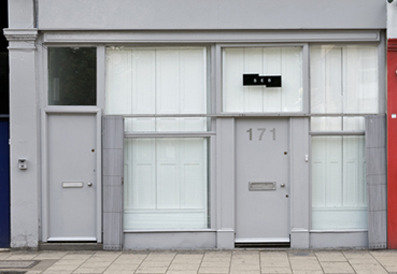Stefan Bruggemann
Dryden Goodwin
Joao Onofre
Hans Op de Beeck
Nicolas de Oliveira
Nicola Oxley
16/2/2011
The half-shut door
SE8, London
In this exhibition a relationship between vision and sound, with priority being given to the auditory. The visual is conspicuous by its absence, having been subsumed by sound, which creates a space for the audience to explore. The work can be seen as being made up of two components, the audio, which is installed in the gallery, and the implied visual, which is alluded to but remains absent in the main space with the exception of documentary evidence.

Stefan Brüggemann
Dryden Goodwin
João Onofre
Hans Op de Beeck
Soundtracks and soundscores tend to accompany major works, in particular they are synchronised elements in cinema. According to Pierre Bourdieu, music escorts and punctuates the visible. Soundtracks, made up of songs were first released separately from films on vinyl in the 1950s, followed by soundscores, essentially compositions that ran the entire length of films.
The legendary score of Bernard Herrmann for Alfred Hitchcock’s film, ‘Vertigo’ is a particularly memorable example (reprised in Douglas Gordon’s ‘Feature Film’), and can be said to even surpass the imagery on the screen; yet, even if we listen to the score on its own, the filmic imagery, though unavailable, nevertheless remains present; the same can also be said for all compositions, but this is especially the case for scores of imaginary events, they always conjure up the visual, its missing part, as in Brian Eno’s collections ‘Music for Films’ or ‘Music for Airports’, a tradition of soundcomposition inspired by real and fictive places that can be traced back to Sergei Rachmaninov’s ‘The Isle of the Dead’ and Modest Mussorgsky ‘Pictures from an Exhibition’.
While the relationship between film and soundcomposition is well established, this is less the case for exhibitions and soundtracks. There has been a bourgeoning trend for artists and composers to collaborate on exhibitions, with a view of extending the remit of the visual. Examples of artists collaborating with composers include Simon Fisher Turner’s score ‘It happened by Chance’(2004) for Derek Jarman’s exhibition of Super 8 films and Loris Gréaud’s ‘Cellar Door: Once is always Twice’(2008), an installation and an opera composed by Thomas Roussel.
For this exhibition, the relationship between vision and sound is inverted, with priority being given to the auditory. The visual is conspicuous by its absence, having been subsumed by sound, which creates a space for the audience to explore. The work can be seen as being made up of two components, the audio, which is installed in the gallery, and the implied visual, which is alluded to but remains absent in the main exhibition space with the exception of documentary evidence. Thus a tension is set up between what is present and what is lacking, that is, the missing work or exhibition. The gallery remains physically empty, referring to ideas of dematerialisation, and yet, it is argued, the sound reverts to a sculptural and spatial material. What is shown is thus not incomplete, a fragment, since the soundscore cannot represent the whole work. Instead, it completes itself in the space through the visitor’s attention.
The body, according to Maurice Merleau-Ponty is both subject and object. This reversibility becomes patent in music where the listener/subject becomes an object through the process of sound, an embodiment of listening processes. Music ceases to be a self-contained whole, but is contaminated by the listening experience: the body as receiver interposes itself as an object.
In the exhibition a soft membrane or threshold separates vision from sound, but the latter permeates the entire space. In their gentle separation vision and sound retain the ability of seeping or leaching together. Unlike the experience in an anechoic chamber in which the listening subject’s attention is turned inward to the sound of blood rushing or breath, the gallery experience is receptive and externalised, the space remaining permeable to sound: sounds emanating from other visitors and the murmur of the street outside mingle with the soundtracks.
'...You are the music while the music lasts.’
Nicolas de Oliveira
Nicola Oxley
T.S. Elliot, The Dry Salvages
SE8 is a not for profit and non commercial visual art space dedicated to exhibiting installation art, based in Deptford, South East London
Private View Thursday 17th February 6.30 - 9pm
SE8
171 Deptford High Street Deptford London
Opening times:
Friday - Saturday 12-6pm or by appointment
Entrance free



